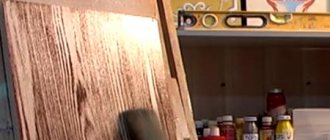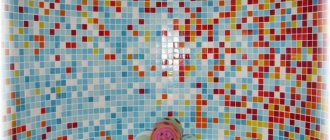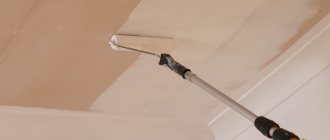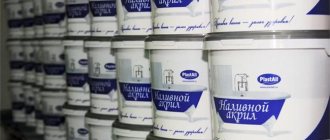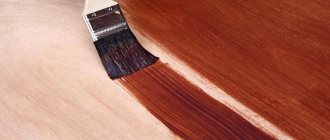One of the most popular finishing materials for many decades is paint.
With its help, doors and window frames are updated. However, rarely has anyone managed to avoid getting the product on the glass or causing unattractive streaks.
Painting yourself always carries the risk of creating difficult-to-clean stains.
The difficulty is that, unlike other common contaminants, paint is not washed off with water or soap solutions. To remove it from the surface, you will have to use one of the methods described below.
Mechanical cleaning
A reliable and affordable way to remove stains from glass surfaces.
It does not require the purchase of special chemical compounds or equipment. Using this technology, it is possible to remove both old and fresh stains. However, it is still recommended to use it only for cleaning small areas, and for larger-scale work to use any of the methods described below. Before you begin cleaning the paint, the surface needs to be prepared.
In particular, attention should be paid to degreasing. To do this, alcohol or another alcohol-containing colorless product is applied to the glass.
Then apply a soft rag soaked in boiling water or just very hot water to the stain. There should be no lint on it.
The material is fixed in such a way that it is held on the surface of the glass quite firmly. If necessary, you can even use tape. The time it takes to soften the paint in this way usually does not exceed a quarter of an hour.
It is possible to add hot water on top of an already attached rag to enhance the effect. After the specified time has passed, the rag is removed, and the paint that has become soft is scraped off with a blade or a stationery knife.
The tool must be held at an angle and used with extreme caution so as not to scratch the fragile glass surface.
Moving step by step, the stain is completely removed, after which the glass is washed to remove paint residues and other contaminants with warm soapy water.
Removing old thick layers of paint
It is better not to use this method if you are dealing with fresh contamination. You will need an iron or a special hair dryer and ordinary food foil. Secure the foil over the contaminated area. It is best to use a larger piece of foil than the area of contamination so that the heat does not reach the tape that should be used to secure the foil. Now direct a stream of warm air onto the foil. After a few minutes, the old layer of paint will soften, after which you need to pry it off with a blade and carefully remove it from the glass.
A process such as removing paint from glass surfaces does not take much work, especially if you use several of the above methods in your arsenal. However, the best remedy is to try not to touch the glass or immediately remove drops of paint with a sponge soaked in solvent, without waiting for them to dry. What methods have you already used? Do you know any other remedies or folk methods that will help remove a layer of paint from glass?
Thermal paint removal
The method has proven itself in working with old and tightly dried stains.
The principle of the technology is to soften the material and destroy its adhesion to the glass surface under high temperature influence. As a tool, you can use a hair dryer or an ordinary iron. A sheet of foil is attached to the glass that has been cleaned from dust and dirt and dried with tape, and then they begin to warm it up with a stream of warm steam or air.
After a few minutes of such exposure, the paint can be easily removed with a sharp blade or thin knife.
Liquid oil
A cotton pad is soaked with this product, which is subsequently applied and fixed on the surface of the glass for several hours.
After a specified period of time, the product is removed with turpentine or soda solution. In this way, you can also clean already dried paint brushes that were not removed from paint residues in a timely manner.
They are simply placed in a container with oil so that the stained areas are completely covered, and after the paint has softened, they are carefully washed with running water.
Mechanical impact
An old, good, proven method that our parents and grandparents used. To begin with, the area stained with paint should be thoroughly treated with any degreaser, for example, alcohol or a special glass cleaner based on it. Now you should apply a soft (preferably lint-free) rag soaked in hot water, or even boiling water, to this area. Secure it so that it does not slide off the contaminated area. This can be done with regular tape. In this position, the hot cloth should act on the surface for about ten to fifteen minutes. You can add hot water a little on top to better affect the paint. After this, you can proceed to active actions: carefully scrape off the paint with a sharply sharpened stationery knife. If you don’t have one, an ordinary blade (the same one that was previously used in old men’s razors) will do just fine.
Solvents
The product line of solvents also includes products specifically designed for cleaning glass. An indication of the suitability of the solvent for such work should be found on the packaging.
These cleaning products are quite aggressive and have a pungent chemical odor, so when working with them, safety precautions must be observed: skin, eyes and respiratory organs must be protected with gloves, goggles and a respirator.
The room should be well ventilated with a constant flow of fresh air.
The essence of the action of absolutely any solvent is to soften the dried coloring material, after which it can be easily and simply removed from the surface. Remains of paint and solvent from the glass are washed off with soapy water.
Precautionary measures
To facilitate repair work, observe the following precautions:
- Before painting, wipe the windows with soapy water. Paint, if it gets on the surface of the window, will not stick to the window and will be removed from the surface without problems.
- When working with chemicals, try to ventilate the room so that harmful fumes do not enter the body along with the air.
- If possible, clean the glass in a horizontal position. This will reduce the risk of breaking it.
When starting a home renovation, you need to be prepared for the fact that you will also have to spend time eliminating your “mistakes” in your work. Don't be upset. If a glass or mirror has been stained with paint, then there are many tips on how to remove paint from glass.
White Spirit
Perhaps the most popular and affordable stain remover is white spirit. The cleaning agent is quite toxic, so you should use gloves and a respirator when working with it.
Contact of the composition with the skin can lead to a burn or an allergic reaction, and white spirit that gets on the fabric can damage its structure and leave permanent marks.
This composition works with glass like this:
- A cotton pad is soaked in cleaning agent and applied to the stain for 30 seconds. Usually this time is enough to separate the paint from the glass. If necessary, paint residues can be removed by re-applying white spirit or mechanically - with a knife or blade.
Chemical method
The most expensive method, as it forces glass owners to purchase expensive chemicals. High costs are paid off thanks to:
- high efficiency;
- cleaning speed;
- safety for glass.
Among the most popular chemical compounds sold in stores, the ones most often chosen to remove stains from paint and varnish products are:
- Liquid oil.
- White Spirit.
- Acetone.
- Kerosene.
- Petrol.
- Other solvents.
White Spirit
A powerful product that removes paint stains from glass surfaces.
Algorithm of actions:
- take a cotton pad or gauze;
- moisten in white spirit;
- apply to the contaminated area;
- We wait a minute.
After this time, the paint will come off the glass and can be easily removed with a regular rag.
Liquid oil
An effective, budget-friendly product that helps remove paint from windows. Due to its cheapness, the product acts more slowly than others, but the end result is practically no different from more expensive analogues. Necessary:
- soak a cotton swab in oil;
- place it on the contaminated area;
- fix for 2-3 hours with tape;
- then remove the cotton wool;
- wipe the stain with a rag soaked in a soda solution.
Solvents
Any chemical substance classified as a solvent will easily remove traces of paint. Such compositions are easy to purchase in specialized stores. They may differ slightly from each other in terms of price, but in terms of effectiveness they are almost identical.
Acetone
An old, proven method that makes it easy to return mirrors to their original appearance. Works great on both old and new stains.
It is enough to apply it on a piece of cotton wool and apply it to the paint mark for a few minutes. At the end of the procedure, wipe the area with a cloth soaked in soapy water.
Special glass cleaning products
Most stores that sell household chemicals sell special solvents designed for cleaning paint from windows and mirrors. They quickly cope with the task, leaving no trace of dirt. Their only drawback is their high price. To wash off the dirt, you will have to spend a lot of money.
Petrol
Purified gasoline, used to refill lighters, effectively dissolves traces of paint left on glass due to carelessness. Simply soak a cotton pad in gasoline and wipe the desired area of the window with it. If the stain is old, fix the cotton wool on the stain for a few minutes. Remains of the substance are removed with a clean cloth moistened with soapy water.
Kerosene
The method of application and the final result are identical to gasoline. These two substances are interchangeable, having similar effects.
Note! When working with any chemical, follow safety precautions and use personal protective equipment.
If the chemical gets on your skin, mucous membranes or clothing, immediately rinse the affected area with plenty of water.
Nail polish remover and acetone
Liquids containing acetone are also suitable for cleaning glass surfaces.
The technology is completely similar to those described above - cotton wool is soaked in cleaning liquid, the stain is fixed on the surface, and after a few minutes the stain is removed with a thin knife or blade.
The glass is thoroughly washed with soapy water and wiped dry. Removing even complex and heavily dried drops and streaks of paint from glass is not difficult, even at home.
However, it is better to pay sufficient attention to preventing the appearance of such stains or try to remove the stains as quickly as possible after they appear.
Each person decides for himself which of the above methods to use, based on the characteristics of the existing contaminants.
How to remove paint from a mirror
When renovating your home or doing crafts projects, you might accidentally spray some paint on a mirror
Also.
If the reflecting surface is covered with glass, all you have to do is carefully clean the glass surface. Try these simple yet effective remedies at home before you decide to replace the mirror itself. Nail polish remover
Dip a piece of cotton wool in nail polish remover and wipe gently over paint spills to clean it up.
Use as much nail polish remover as necessary and as much pressure as you think the glass surface can stand. Ensure you don't break the glass. Most paints should respond to this treatment without harming the surface of the mirror. Acetone
If nail polish remover doesn't work, try acetone instead.
This is just a stronger form of nail polish remover. You might want to use gloves though when using acetone. This will also remove the paint without leaving any scratches on the surface of the mirror. Use cotton balls or cotton cloth to wipe up paint spills. Here too you have to rub constantly to get the paint off the surface of the mirror. Using Thinner
Use thinner if the paint has hardened and does not respond to nail polish remover or acetone.
Dip a soft cotton cloth into the thinner and rub vigorously over the painted surface. Use both gloves and a mask when handling thinner, especially if you are allergic to this substance. This should remove most stains even stubborn paints. Try leaving some thinner on the hardened paint and wait for it to dissolve the paint. Then it will be easy to wipe off. Sharp Blade
If even thinner doesn't work, then you have no choice but to use a sharp blade, get a new one, and scrape the paint thoroughly from the mirror surface.
You should do your best to ensure that you do not scratch the surface of the mirror while doing this. The key word here is gentleness. You can't afford to put too much pressure on the mirror, or it will break or the glass will show scratches. Be gentle and you should be able to achieve your goal. Conclusion
It might be cheaper to replace the mirror rather than risk scratching it by using a new blade. You should take a request whether you want to keep the old mirror or not. These are the ways you can go about removing the mirror from the paint. Most of the things you need can be found in any hardware store. You don't need any very special equipment to remove paint speck. A little effort and the right decision will soon rid your mirror of ugly paint stains and other blemishes. You will then have a bright and flawless mirror that will be a pleasure to look at.

